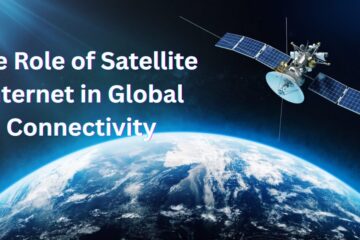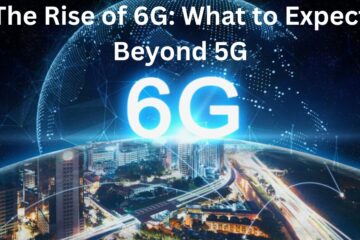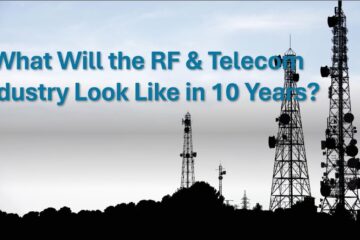As we approach the mid-2020s, the world of telecommunications and radio frequency technology continues to evolve at a rapid pace. From faster internet speeds to more reliable communication networks, the top technology in telecommunication and radio frequency is becoming increasingly essential for personal, professional, and commercial use. In this blog, we will explore some of the top technologies that will define the telecommunications and radio frequency landscape in 2025-26, including advancements that promise to improve connectivity, reliability, and efficiency.
5G and Beyond: The Future of Mobile Communication
The rollout of 5G networks has already begun, but by 2025-26, this technology is expected to be fully integrated worldwide. 5G, the fifth generation of mobile network technology, promises lightning-fast internet speeds, reduced latency, and massive improvements in capacity and connectivity. As one of the top technologies in telecommunication, 5G will revolutionize everything from personal communications to the Internet of Things (IoT) and autonomous vehicles.
However, the evolution doesn’t stop at 5G. The telecommunications industry is already working on the next generation of mobile networks, known as 6G. Expected to be deployed in the 2030s, 6G will promise even faster speeds, higher bandwidth, and ultra-low latency. The research and development happening now will pave the way for future advances in connectivity, making 6G one of the top best technologies in 2025-26 to look out for.
AI and Machine Learning in Telecommunication
Artificial Intelligence (AI) and Machine Learning (ML) are not just buzzwords—they are becoming integral to the way telecommunication networks are managed. In 2025-26, AI and ML will be increasingly leveraged to optimize network performance, predict traffic patterns, and improve customer service.
AI-powered systems will be used to automate network maintenance, enabling real-time problem detection and resolution. Additionally, ML algorithms will help predict network demand, ensuring that resources are allocated efficiently to avoid congestion and downtime. This level of automation and intelligent decision-making will make the telecom industry more reliable and responsive, making AI and ML an important top technology in telecommunication.
Network Slicing: Optimizing 5G Networks
Network slicing is another top technology in telecommunication that will become more widespread in 2025-26, particularly in the context of 5G networks. Essentially, network slicing allows operators to create multiple virtual networks within a single physical 5G infrastructure. This enables them to tailor specific network slices for different use cases and industries, ranging from low-latency services for gaming to high-speed connections for industrial IoT devices.
By providing customized network performance based on the needs of the user, network slicing will improve the efficiency and scalability of 5G networks. For industries such as healthcare, autonomous driving, and manufacturing, this technology could provide dedicated, mission-critical communication channels. As a result, network slicing will be pivotal in supporting the diverse applications of 5G and beyond.
Quantum Computing and Cryptography
Although quantum computing is still in the experimental phase, it is expected to play a significant role in telecommunications by 2025-26. Quantum computing uses principles of quantum mechanics to solve complex problems much faster than traditional computers. As the demand for faster data processing continues to grow, quantum computing could enable telecom companies to better handle massive amounts of data and improve overall network performance.
Additionally, quantum cryptography is emerging as a way to enhance security in telecommunication networks. By using quantum encryption methods, telecom companies can create virtually unbreakable encryption systems that ensure the confidentiality of sensitive communications. With cyber threats becoming more sophisticated, this is an important technological advancement that will help secure networks in the coming years.
Wi-Fi 6 and Wi-Fi 7: The Evolution of Wireless Networking
Wi-Fi 6 is already available, and Wi-Fi 7 is on the horizon, making them some of the top technologies in telecommunication that are expected to gain prominence in 2025-26. These new wireless standards will offer faster speeds, increased capacity, and lower latency compared to previous Wi-Fi versions.
Wi-Fi 6 will be a game-changer for environments with high device density, such as stadiums, airports, and office buildings. It allows for more efficient use of the spectrum and can handle a larger number of devices simultaneously without compromising speed. Wi-Fi 7, expected to arrive in the next few years, will build on these improvements, offering even faster speeds and enhanced connectivity for ultra-high-definition streaming, virtual reality, and other bandwidth-intensive applications.
As businesses and consumers continue to demand faster and more reliable wireless internet, these Wi-Fi technologies will become essential components of the telecommunications infrastructure in 2025-26.
Edge Computing: Reducing Latency and Improving Efficiency
Edge computing is another emerging technology that will become increasingly important in the telecommunications industry by 2025-26. This technology involves processing data closer to the source of the data, rather than relying on a centralized cloud server. By reducing the distance that data needs to travel, edge computing minimizes latency and enhances the overall speed and responsiveness of applications.
In the context of telecommunications, edge computing will enable real-time communication and data processing, making it ideal for applications that require ultra-low latency, such as autonomous vehicles, remote surgeries, and smart cities. By offloading data processing tasks to the edge of the network, telecom companies can create more efficient and scalable systems, ensuring faster and more reliable service for users.
Radio Frequency (RF) Technology: Advancements in Spectrum Management
Radio Frequency (RF) technology has been a cornerstone of telecommunications for decades, but as the demand for wireless services grows, the need for more efficient spectrum management becomes increasingly critical. RF technology advancements will play a central role in improving the efficiency of wireless communication systems in 2025-26.
One of the top technologies in radio frequency that is expected to gain traction in the coming years is Dynamic Spectrum Access (DSA). DSA allows telecom providers to more efficiently utilize available spectrum by enabling devices to automatically detect and access underutilized frequency bands. This dynamic approach to spectrum allocation will help alleviate congestion in highly populated areas and improve overall network performance.
Another promising RF technology is massive MIMO (Multiple Input, Multiple Output), which uses a large number of antennas to simultaneously transmit and receive multiple data streams. This technology, when integrated with 5G and beyond, will dramatically increase data throughput and network capacity, making it essential for the next generation of wireless communication.
Satellite Internet: Expanding Global Connectivity
Satellite internet is rapidly gaining attention as a solution to provide reliable, high-speed internet access to underserved and remote regions. With the launch of low Earth orbit (LEO) satellite constellations, companies like SpaceX (Starlink) and Amazon (Project Kuiper) are working to provide global internet coverage.
By 2025-26, satellite internet will become a top technology in telecommunication, offering connectivity in rural and remote areas where traditional broadband infrastructure is not feasible. This expansion of internet access will have a significant impact on global communication, enabling millions of people to connect to the internet and participate in the digital economy.
Conclusion
The top technology in telecommunication and top technology in radio frequency will continue to evolve in 2025-26, driven by innovations in 5G, AI, quantum computing, and more. As we move toward an increasingly connected world, these technologies will play a critical role in shaping how we communicate, work, and live. With the continuous push for faster, more reliable, and secure communication systems, the next few years promise to bring exciting advancements to the telecommunications and radio frequency sectors, offering greater opportunities and improved experiences for consumers and businesses alike.



0 Comments